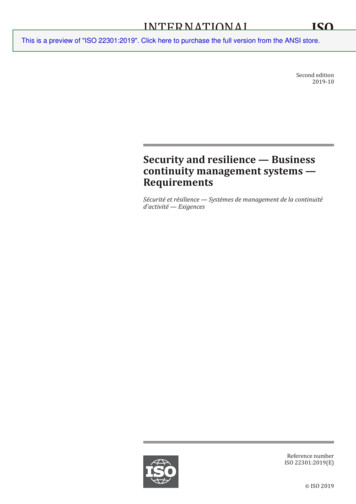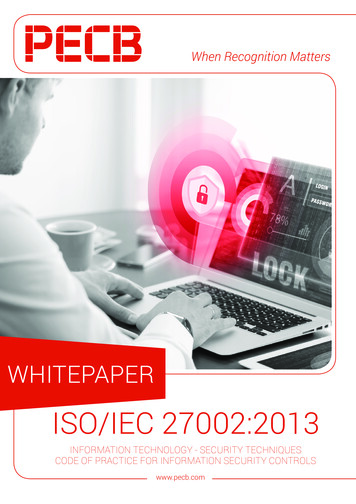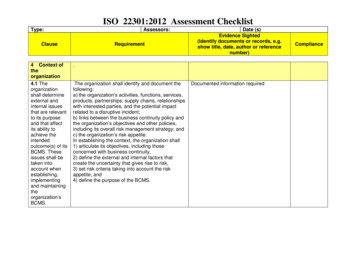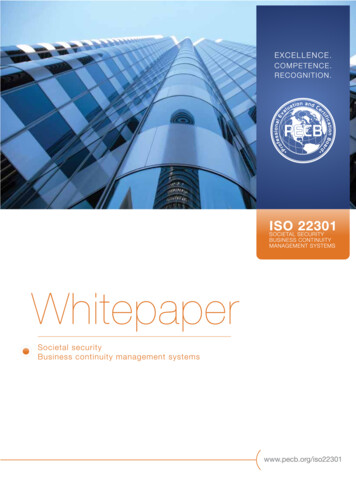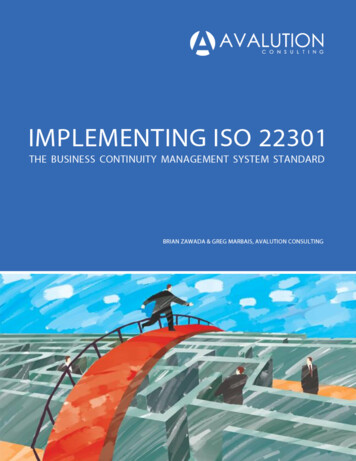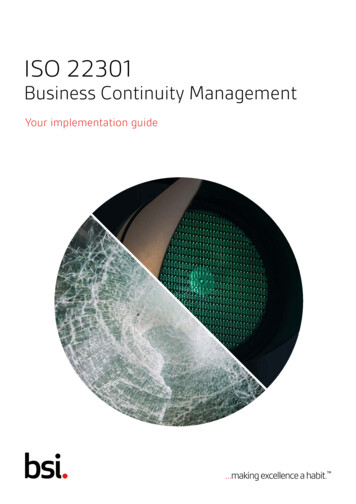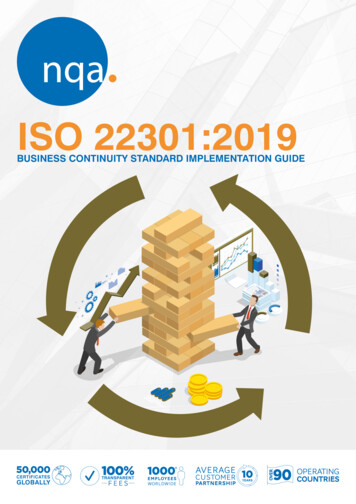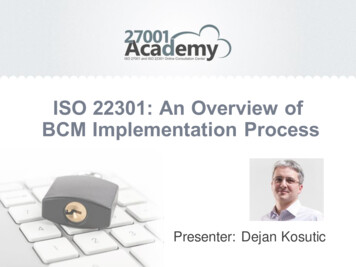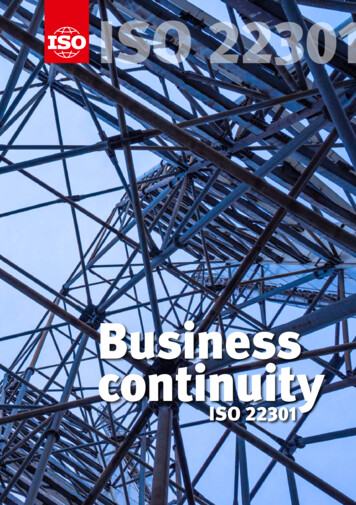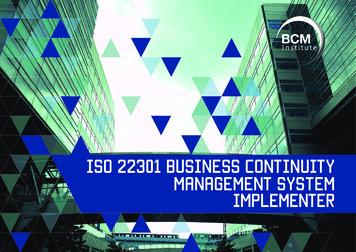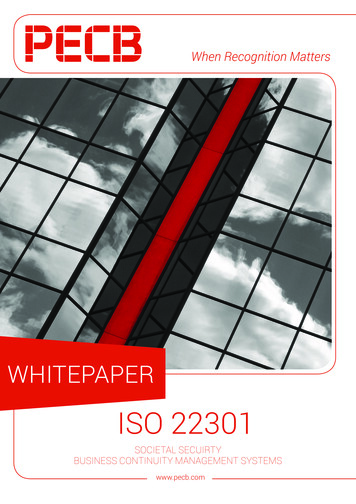
Transcription
When Recognition MattersWHITEPAPERISO 22301SOCIETAL SECUIRTYBUSINESS CONTINUITY MANAGEMENT SYSTEMSwww.pecb.com
PRINCIPAL AUTHORSRené St-GERMAIN, PECB (France), Faton ALIU, PECB (Canada), Eric LACHAPELLE , PECB (Canada),Pierre DEWEZ, Devoteam (Belgium)CONTRIBUTORSIan BELL (UK) Yannick BERNERON, Egyde (Canada) Daniela CATALIN, IT Academy (Romania) Goran CHAMUROVSKI, INTEGRA Solution (Macedonia) Jacques CHENEVIERE, Devoteam (France) Marcelo CORREA, Behaviour (Brasil) Karsten M. DECKER, Decker Consulting (Switzerland) Jérôme FERRU, Devoteam (France) Karim HAMDAOUI, LMPS Consulting (Morocco) Emile KOK,TSTC (Netherlands) Mathieu LACHAINE, Kereon (Canada) Jan MAES, Devoteam (Belgium) Simona MOSTEANU (Belgium) Graeme PARKER, Parker Solutions (UK) Dirk PAUWELS,Devoteam (Belgium) Joaquim PEREIRA, Behaviour (Portugal) Sébastien RABAUD, SCASSI (France) Itzhak SHARON, GSECTRA (Israel) François TÊTE, Devoteam (France) Gilles TROUESSIN,SCASSI (France) Alexandrine VILLE, SEKOIA (France) Richard G. WILSHER, Zygma (USA)CONTENTS3Introduction4An overview of ISO 22301:20124Key clauses of ISO 22031:20127Link between ISO 22301 and other standards7Link with other business continuity standards9Link with ISO 2700110Integration with other management systems11Business Continuity Management - The Business Benefits12Implementation of a BCMS with IMS2 methodology13Certification of organizations14Training and certifications of professionals2ISO 22301 // SOCIETAL SECURITY BUSINESS CONTINUITY MANAGEMENT SYSTEMS
INTRODUCTIONRecent natural disasters, environmental accidents,technology mishaps and man-made crises havedemonstrated that severe incidents can and will happen,impacting the public and private sectors alike. The challengegoes beyond providing an emergency response plan or usingdisaster management strategies that were previously used.Organizations of all sizes and types should now engage ina comprehensive and systematic process of prevention,protection, preparedness, mitigation, response for businesscontinuity and recovery. It is no longer enough to drafta response plan that anticipates and minimizes theconsequences of naturally, accidentally, or intentionallycaused disruptions, but rather organizations must also takeadaptive and proactive measures to reduce the likelihoodof a disruption. Today’s threats require the creation of anon-going, managed process that ensures the survival andsustainability of an organization’s core activities before,during, and after a disruptive event.The ability of an organization to recover from a disaster isdirectly related to the degree of business continuity planningthat has taken place BEFORE the disaster. Studies show thattwo out of five businesses that experience a disaster will goout of business within five years of the event.Business continuity plans are critical to the continuousoperation of all types of businesses. More importantly, theseplans are assuming increased importance as companiesbecome increasingly reliant on technology to do business.According to research by the METAGroup, the potential financial lossdue to downtime is staggering. Foran online retailer, the hourly loss isover one million dollars, on average.For a financial institution, the averagehourly loss is closer to 1.5 million.And for utility companies such astelecommunications and energy, thepotential loss can reach as high as 2.8million per hour. That’s over 67 millionin a day. Or, 24.5 billion per yearDespite this clear message that downtime is disastrous,Gartner research shows that less than 30 percent of Fortune2000 companies have invested in a full business continuityplan. The reason for this oversight may simply be that thetechnical challenges seem to be too daunting. Or perhapsthe cost of implementation isperceived as too great. All of these are viable concerns, butthey can be addressed with business continuity solutions.ISO 22301, the world’s first international standard for BusinessContinuity Management (BCM), has been developed to helporganizations minimize the risk of such disruptions. ISO hasofficially launched ISO 22301, “Societal security - Businesscontinuity management systems – Requirements”, the newinternational standard for Business Continuity ManagementSystem (BCMS). This standard will replace the current Britishstandard BS 25999.ISO 22301 // SOCIETAL SECURITY BUINESS CONTINUITY MANAGEMENT SYSTEMS3
AN OVERVIEW OF ISO 22301:2012ISO 22301 specifies requirements to plan, establish, implement, operate, monitor, review, maintain andcontinually improve a documented management system to prepare for, respond to and recover fromdisruptive events when they arise.The requirements specified in ISO 22301 are generic and intendedto be applicable to all organizations (or parts thereof), regardless oftype, size and nature of the organization. The extent of applicationof these requirements depends on the organization’s operatingenvironment and complexityBusiness continuity standardization evolves with ISO 22301 byadding: Greater emphasis on setting the objectives, monitoringperformance and metrics; Clearer expectations on management; More careful planning for and preparing the resources neededfor ensuring business continuity;What is BusinessContinuity Management?BCM is a holistic management processthat identifies potential threats toan organization and the impacts tobusiness operations those threats,if realized, might cause, and whichprovides a framework for buildingorganizational resilience with thecapability for an effective responsethat safeguards the interests of its keystakeholders, reputation, brand andvalue-creating activitiesISO 22301 applies to all types and sizes of organizations that wish to:1. establish, implement, maintain and improve a BCMS;2. assure conformity with the organization’s stated business continuity policy;3. demonstrate conformity to others;4. seek certification/registration of its BCMS by an accredited third party certification body; or5. make a self-determination and self-declaration of conformity with this International Standard.ISO 22301 is the first standard to be fully compliant with the new guidelines from ISO/Guide 83 (“Highlevel structure and identical text for management system standards and common core managementsystem terms and definitions”). It has been developed in response to standards users’ critics that, whilecurrent standards have many common components, they are not sufficiently aligned, making it difficult fororganizations to rationalize their systems and to interface and integrate them.This means that ISO 22301 will be the first standard to fully integrate a high-level structure and commontext that will make it totally aligned with all other management systems once the related standards havealso adopted the ISO Guide 83 guidelines.KEY CLAUSES OF ISO 22301:2012ISO 22301 applies to all types and sizes of organizations that wish to:Clause 4: Context of the organizationClause 5: LeadershipClause 6: PlanningClause 7: SupportClause 8: OperationClause 9: Performance evaluationClause 10: ImprovementEach of these key activities is listed below.4ISO 22301 // SOCIETAL SECURITY BUSINESS CONTINUITY MANAGEMENT SYSTEMS
CLAUSE 4: CONTEXT OF THE ORGANIZATIONDetermine external and internal issues that are relevant toMissionits purpose and that affect its ability to achieve theBUSINESSexpected outcomes of its BCMS such VES the organization’s activities, functions, services,Objectivesproducts, partnerships, supply chains,relationships with interested parties, and the potentialimpact related to a disruptive incident; links between the business continuity policy and theorganization’s objectives and other policies, includingits overall risk management strategy;Business Continuity PolicyCorporate Policy the organization’s risk appetite; the needs and expectations of relevant interested parties; applicable legal, regulatory and other requirements to which the organization subscribes.Identifying the scope of the BCMS, taking into account the organization’s strategic objectives, key products andservices, risk tolerance, and any regulatory, contractual or stakeholder obligations is also part of this clauseCLAUSE 5: LEADERSHIPTop management needs to demonstrate an ongoing commitment to the BCMS. Through its leadership andactions, management can create an environment in which different actors are fully involved and in whichthe management system can operate effectively in synergy with the objectives of the organization. Theyare responsible for: ensuring the BCMS is compatible with the strategic direction of the organization; integrating the BCMS requirements into the organization’s business processes; providing the necessary resources for the BCMS; communicating the importance of effective business continuity management; ensuring that the BCMS achieves its expected outcomes; directing and supporting continual improvement; establish and communicate a business continuity policy; ensuring that BCMS objectives and plans are established; ensuring that the responsibilities and authorities for relevant roles are assigned.CLAUSE 6: PLANNINGThis is a critical stage as it relates to establishing strategic objectives and guiding principles for the BCMSas a whole. The objectives of a BCMS are the expression of the intent of the organization to treat the risksidentified and/or to comply with requirements of organizational needs. The business continuity objectivesmust: be consistent with the business continuity policy; take into account the minimum level of products and services that is acceptable to the organization toachieve its objectives; be measurable; take into account applicable requirements; be monitored and updated as appropriateCLAUSE 7: SUPPORTThe day-to-day management of an effective business continuity management system relies on using theappropriate resources for each task. These include competent staff with relevant (and demonstrable)training and supporting services, awareness and communication. This must be supported by properlymanaged documented information.ISO 22301 // SOCIETAL SECURITY BUINESS CONTINUITY MANAGEMENT SYSTEMS5
Both internal and external communications of the organization must be considered in this area, includingthe format, the content and the proper timing of such communications.The requirements on the creation, update and control of documented information are also specified in thisclause.CLAUSE 8: OPERATIONAfter planning the BCMS, an organization must put it in operation.This clause includes:Business Impact Analysis (BIA): This activity enables an organization to identify the critical processesthat support its key products and services, the interdependencies between processes and the resourcesrequired to operate the processes at a minimally-acceptable level.Risk assessment: ISO 22301 proposesto refer to the ISO 31000 standard toimplement that process. The goal of thisrequirement is to establish, implement,and maintain a formal documented riskassessment process that systematicallyidentifies, analyzes, and evaluates the riskof disruptive incidents to the organization.Process ofanalysingbusinessfunctions andthe effect thatthe businessdisruption mighthave upon llprocess of riskidentification,risk analysisand riskevaluationBusiness continuity strategy: After requirements have been established through the BIA and the riskassessment, strategies can be developed to identify arrangements that will enable the organization toprotect and recover critical activities based on organizational risk tolerance and within defined recovery timeobjectives. Experience and good practice clearly indicate that the early provision of an overall organizationalBCM strategy will ensure BCM activities are aligned with and support the organization’s overall businessstrategy. The business continuity strategy should be an integral component of an institution’s corporatestrategyBusiness continuity procedures: The organization shall document procedures (including necessaryarrangements) to ensure continuity of activities and management of a disruptive incident. The procedureshave to: establish an appropriate internal and external communications protocol; be specific regarding the immediate steps that are to be taken during a disruption; be flexible to respond to unanticipated threats and changing internal and external conditions; focus on the impact of events that could potentially disrupt operations; be developed based on stated assumptions and an analysis of interdependencies; and; be effective in minimizing consequences through implementation of appropriate mitigation strategies.Exercising and testing: To ensure that business continuity procedures are consistent with its businesscontinuity objectives, an organization will have to test them regularly. Exercising and testing are theprocesses of validating business continuity plans and procedures to ensure the selected strategies arecapable of providing response and recovery results within the timeframes agreed to by management.CLAUSE 9: PERFORMANCE EVALUATIONOnce the BCMS is implemented, ISO 22301requires permanent monitoring of the system as well as periodicreviews to improve its operation: monitoring the extent to which the organization’s business continuity policy, objectives and targets aremet; measuring the performance of the processes, procedures and functions that protect its prioritizedactivities; monitoring compliance with this standard and the business continuity objectives; monitoring historical evidence of deficient BCMS’ performance conducting internal audits at plannedintervals; and evaluating all this in the management review at planned intervals6ISO 22301 // SOCIETAL SECURITY BUSINESS CONTINUITY MANAGEMENT SYSTEMS
Exercise TypeW
ISO 22301 specifiesrequirements to plan, establish, implement, operate, monitor, review, maintain and continually improve a documented management system to prepare for, respond to and recover from disruptive events when they arise. The requirements specifiedin ISO 22301 are generic and intended to be applicable to all organizations (or parts thereof), regardless of type, size and nature of the .

